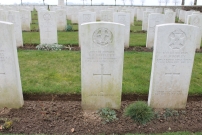| First Name: | George Ernest | Last Name: | BARTLETT | |
|---|---|---|---|---|
| Date of Death: | 13/04/1917 | Lived/Born In: | Maida Vale | |
| Rank: | Private | Unit: | Middlesex7 | |
| Memorial Site: | ||||
Current Information:Age-23 62, Warlock Road, Maida Vale Warlincourt Halte British Cemetery, Saulty, France
The Battle of Arras was a series of offensives by the British Army between 9th April 1917 and 16th May 1917. It had been planned in conjunction with the French who would attack in Artois and between them the Allies would force the Germans out of the large salient they had held since the line of trenches was first established. But the Germans had spoiled this plan by falling back to the new and very strong Hindenburg Line in January 1917 and the salient no longer existed. For the want of an alternative plan the attack went ahead anyway. It all started well for the British who made substantial gains on the first two days but then the offensive ground to a halt and by the end their losses amounted to over 150,000. The First Battle of the Scarpe (9-14 April) 56th (London) Division attacked at 7.45 on the morning of 9th April, 1917 with their objective being the Wancourt-Feuchy trench system, the Brown line. 167 Brigade attacked on the right of the divisional front with 3rd London on the right and 8th Middlesex on the left, their first objective being the southern half of the heavily fortified village of Neuville-Vitasse after which 1st London and 7th Middlesex would pass through to continue the attack. Two platoons of 3rd London had the additional task of capturing Neuville Mill which they succeeded in doing with the help of a tank. 3rd London reached their objective without meeting too much opposition but 8th Middlesex had a harder fight and were held up around the church where the wire was uncut. Eventually after a hard fight, this was overcome but 8th Middlesex had lost the barrage and it was only with difficulty that they reached their final objective at 4pm. Despite this 1st London was able to pass through to the south of them at 12.10pm and attack the Hindenburg Line. They cleared Neuville-Vitasse Trench but suffered heavy casualties in the process and when 7th Middlesex moved up for their advance, they found 1st London held up in front of the Hindenburg Line. They immediately went to their aid and between them 7th Middlesex and 1st London captured the first part of the Hindenburg Line.However, in the confusion of battle, the troops had bunched together and were not in touch with 168 Brigade on their left. Later 7th Middlesex twice attacked the support trench but were stopped both times by machine-gun fire from the right. By the end of the day, 56th Division had advanced some 2000 yards, but not without cost having sustained over 800 casualties. At 3am on the following day, 10th April, the attack was resumed after a fresh supply of bombs had been brought up. 7th Middlesex cleared some of Ibex Trench and then at 2.15pm, along with 9th London and after an earlier failure at noon, they once again turned their attention to the rest of Ibex Trench and Zoo Trench and this too was taken along with many prisoners. By 4.30pm, 7th Middlesex were consolidating in a shallow trench parallel with the Wancourt-Feuchy line. Early the following morning they bombed their way down Puma and Ibex Trenches and by 5am had established posts at their junctions with Nepal trench where small enemy counter attacks were easily beaten off and 118 more prisoners captured. At 5.30am a bombing party from 8th Middlesex arrived and began bombing up Nepal Trench. Enemy snipers held them up until 7th Middlesex brought a Lewis gun into action and their advance continued. They kept at it all day taking another 23 prisoners and by 4.15pm Nepal trench had been completely cleared. That evening both battalions were relieved and 7th Middlesex moved back to Agny. The battalion had sustained over 100 casualties during the first three days of the battle, including George Bartlett who died from wounds on 13th April. |
||||
| « Back to Search Results | ||||
| If you think any of the information shown here is incorrect, Click Here to submit your amends and comments | ||||




